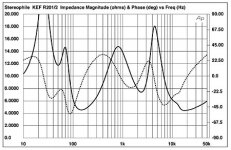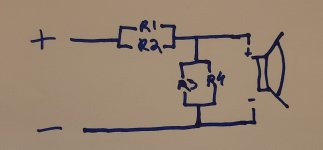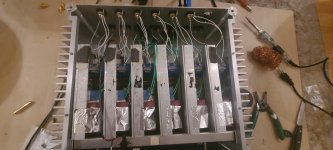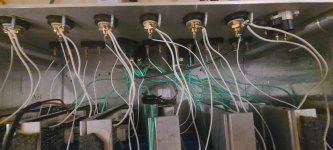 Moderation edit: TLDR, start at post #10.
Moderation edit: TLDR, start at post #10.This began as a speaker thread asking to attenuate the speakers to reduce hum, and has now become an amp noise thread.
----------

So I deceided to go back to trying active again. I'm trying to connect a very powerful 6 channel amplifier I have
directly to speakers, using an active crossover and bypassing the internal crossovers. The amps are 6 - 500asp
Icepower modules. Running this much power to a tweeter
does make me a tad nervous. Also, there's some hiss and hum
I'd like to attenuate. I'd be using the 6 channel dac as a volume control.
I called Solen about whether to use an lpad or resistors and the
tech advised me to use resistors instead to pad the drivers down
using one series and one parallel resistor per driver.
So being that its a 3 way I'm thinking 9 db for the tweeter, 6db for the
mid and 3 db for the woofer. I think the tweeter is around 91db efficient,
the mid around 88 and the woofer 85 db.
My question is two fold, firstly does the resistor wattage in this case
matter that much? The thing is these amps are capable of sending
out 250 watts each, I know the drivers wont receive anywhere near
that being that I dont listen that loud and the signal will be crossed
at 450 and 2750hz. What is the minimum wattage resistor you would
use in this case?
For the parallel resistor can I just run it along the neg and pos binding
posts and then one from the pos inside the speaker?
Using this chart from Solen I've determined the following values: Solen Electronique Inc. | Values for L-Pads
tweeter - 9db attenuation: series resistor 3.9ohm parallel 3.3ohm
mid - 6db attenuation: series resistor 3.0ohm parallel 6.2ohm
woofer - 3db attenuation: series resistor 1.8ohm parallel 15ohm
I was thinking about using these 16watt mill spec resistors:
Solen Electronique Inc. | Product categories | AchrOhmiC MIL Spec Resistors
Ive attached a pic of the speaker impedance chart. Should I be ok with this?
Attachments
"For the parallel resistor can I just run it along the neg and pos binding
posts and then one from the pos inside the speaker?"
You have to reverse the order of the resistors to make an L-pad. Series first, then shunt.
Otherwise, probably this will work ok, if the volume is kept low.
Most would want to use large series capacitors on the mid and tweeter for protection.
You may want to do that at least for the initial testing and setup.
posts and then one from the pos inside the speaker?"
You have to reverse the order of the resistors to make an L-pad. Series first, then shunt.
Otherwise, probably this will work ok, if the volume is kept low.
Most would want to use large series capacitors on the mid and tweeter for protection.
You may want to do that at least for the initial testing and setup.
Last edited:
You have to reverse the order of the resistors to make an L-pad. Series first, then shunt.
Otherwise, probably this will work ok, if the volume is kept low.
Most would use large series capacitors on the mid and tweeter for protection.
You may want to do that at least for the initial testing and setup.
Awesome thanks!
I'll look into caps too to protect the tweeters.
The 16W rating should be fine for the tweeters, but for the mid and woofer it could be marginal
if the volume is turned up very much. I'd consider paralleled pairs (of equal values), for each series
and for each parallel resistor, to be safe.
To choose a uF value for each of the the protection capacitors, calculate the uF value using
the crossover point you want, and multiply that by 10 times larger. That way it won't interfere
with the active crossover action much. You could start with cheap bipolar electroytics.
if the volume is turned up very much. I'd consider paralleled pairs (of equal values), for each series
and for each parallel resistor, to be safe.
To choose a uF value for each of the the protection capacitors, calculate the uF value using
the crossover point you want, and multiply that by 10 times larger. That way it won't interfere
with the active crossover action much. You could start with cheap bipolar electroytics.
Last edited:
"woofer - 3db attenuation" - why are you attenuating the woofer??? - don't.
A useful calculator:
L pad calculator - attenuation dB damping impedance decibel loudspeaker speaker voltage divider - sengpielaudio Sengpiel Berlin
A useful calculator:
L pad calculator - attenuation dB damping impedance decibel loudspeaker speaker voltage divider - sengpielaudio Sengpiel Berlin
"woofer - 3db attenuation" - why are you attenuating the woofer??? - don't.
A useful calculator:
L pad calculator - attenuation dB damping impedance decibel loudspeaker speaker voltage divider - sengpielaudio Sengpiel Berlin
Because the woofer in this particular speaker is a very shallow slope and
I want to attenuate hiss and hum from the amp.
The 16W rating should be fine for the tweeters, but for the mid and woofer it could be marginal
if the volume is turned up very much. I'd consider paralleled pairs (of equal values), for each series
and for each parallel resistor, to be safe.
To choose a uF value for each of the the protection capacitors, calculate the uF value using
the crossover point you want, and multiply that by 10 times larger. That way it won't interfere
with the active crossover action much. You could start with cheap bipolar electroytics.
DO you mean like this?
Attachments
Last edited:
I think you'd be better to do your attenuation at line level, i.e. the outputs of the active crossover.
You could add trim pots there, & power rating wouldn't be a consideration.
You could add trim pots there, & power rating wouldn't be a consideration.
I think you'd be better to do your attenuation at line level, i.e. the outputs of the active crossover.
You could add trim pots there, & power rating wouldn't be a consideration.
Update: I decided to try your way first and do a line level L-Pad with a 5.6k in series and a 3.3k in parallel. Well....it did attenuate the signal some, but the HUM was much worse ! Which is the main reason I wanted to attenuate in the first place 🙁
So I'm thinking the problem lies somewhere else in the amplifier. I tried different configurations and rca cables, nothing fixed the hum. Im thinking the wiring might not be great inside . Ive been doing reading on twisting wires for hum rejection. Could something this simple be a solution for me?
Regards,
Eli
Here's a picture of the inside, I had someone who does mods professionally
help me with upgrading the internal wire and adding some input transformers to raise the input impedance, but the hum did get worse. Could twisting these wire and resoldering them potentially improve the hum? I think its mostly 120hz.
Here's some pics:
help me with upgrading the internal wire and adding some input transformers to raise the input impedance, but the hum did get worse. Could twisting these wire and resoldering them potentially improve the hum? I think its mostly 120hz.
Here's some pics:
Attachments
Throw your scope around, measure the outputs with the inputs shorted, look at the supply rails.
Your woofer is 85dB, you should not need to attenuate.Because the woofer in this particular speaker is a very shallow slope and
I want to attenuate hiss and hum from the amp.
You're probably right. I wish I had the know-how to do a thorough check but I am unsure as to how to proceed. I wonder if I had gone with one of those PCB board input buffers instead of the Cinemag 2:1 Xformers if the hum would have been attenuated more.
Hum & hiss removal from amplifier is done at the factory and hard to reverse engineer. That 6 channel amp looks to have enough heat sink for about two 500 w channels. Several of my amps have inaudible hiss & hum using 99 db 1w1m speakers. Such tricks as putting a steel cage around the power transformer, copper band around e-core transformer, hum rejection in the driver circuits, putting high gain circuits the opposite side of the case from the transformer, etc.
You live in Canada, go shopping. Craigslist or ebay amp for parts or repair.
Amps I've bought & repaired with inaudible hiss & hum, Peavey M-2600 $105 working low wattage, PV-4c $40 blown output transistor's, CS-800s $100 with burnt input resistors & another $140 working low wattage, Peavey MMA-875t (mono) $40 bad solder joint causing silence, another $70 working, Peavey MMA-1502 (mono) $60 bad solder joint causing silence. Those prices are with freight. Crown & QSC amps are also reputable & schematics are available. I support some QSC amps at 2 churches and they don't hiss or hum. It is easier IMHO to repair a blown amp than re-engineer the hum out of a bad one.
The hiss might be cheaper to get out; usually obsolete cheap op amps and or a lot of carbon comp high value resistors.
My own home mod dynakit ST120 has developed a hum problem and I'm having trouble finding the source. Was pretty good a couple of years, then a wire popped loose and I put it back wrong somehow. Meanwhile the M-2600 is playing up to spec with just a few expired capacitors replaced. No thought required in that process.
In particular you won't need 500 w for a tweeter. Peavey builds 500 w full 54-17 khz speakers with a 70 W tweeter. Pink noise doesn't load the tweeter more than that with a 2000 hz crossover. A MMA-875t or crown M2160 would be fine. Note the really cheap MMA mono amps have a series transformer that rolls off @ 50 Hz, so it is not suitable for subwoofers.
Start another thread in amps solid state about any amp you buy if you wish.
You live in Canada, go shopping. Craigslist or ebay amp for parts or repair.
Amps I've bought & repaired with inaudible hiss & hum, Peavey M-2600 $105 working low wattage, PV-4c $40 blown output transistor's, CS-800s $100 with burnt input resistors & another $140 working low wattage, Peavey MMA-875t (mono) $40 bad solder joint causing silence, another $70 working, Peavey MMA-1502 (mono) $60 bad solder joint causing silence. Those prices are with freight. Crown & QSC amps are also reputable & schematics are available. I support some QSC amps at 2 churches and they don't hiss or hum. It is easier IMHO to repair a blown amp than re-engineer the hum out of a bad one.
The hiss might be cheaper to get out; usually obsolete cheap op amps and or a lot of carbon comp high value resistors.
My own home mod dynakit ST120 has developed a hum problem and I'm having trouble finding the source. Was pretty good a couple of years, then a wire popped loose and I put it back wrong somehow. Meanwhile the M-2600 is playing up to spec with just a few expired capacitors replaced. No thought required in that process.
In particular you won't need 500 w for a tweeter. Peavey builds 500 w full 54-17 khz speakers with a 70 W tweeter. Pink noise doesn't load the tweeter more than that with a 2000 hz crossover. A MMA-875t or crown M2160 would be fine. Note the really cheap MMA mono amps have a series transformer that rolls off @ 50 Hz, so it is not suitable for subwoofers.
Start another thread in amps solid state about any amp you buy if you wish.
Last edited:
No problem, do you want to try moving the thread to another section?
Sure! Is this something you can do or should I sinply restart the thread in another section ?
Hum & hiss removal from amplifier is done at the factory and hard to reverse engineer. That 6 channel amp looks to have enough heat sink for about two 500 w channels. Several of my amps have inaudible hiss & hum using 99 db 1w1m speakers. Such tricks as putting a steel cage around the power transformer, copper band around e-core transformer, hum rejection in the driver circuits, putting high gain circuits the opposite side of the case from the transformer, etc.
You live in Canada, go shopping. Craigslist or ebay amp for parts or repair.
Amps I've bought & repaired with inaudible hiss & hum, Peavey M-2600 $105 working low wattage, PV-4c $40 blown output transistor's, CS-800s $100 with burnt input resistors & another $140 working low wattage, Peavey MMA-875t (mono) $40 bad solder joint causing silence, another $70 working, Peavey MMA-1502 (mono) $60 bad solder joint causing silence. Those prices are with freight. Crown & QSC amps are also reputable & schematics are available. I support some QSC amps at 2 churches and they don't hiss or hum. It is easier IMHO to repair a blown amp than re-engineer the hum out of a bad one.
The hiss might be cheaper to get out; usually obsolete cheap op amps and or a lot of carbon comp high value resistors.
My own home mod dynakit ST120 has developed a hum problem and I'm having trouble finding the source. Was pretty good a couple of years, then a wire popped loose and I put it back wrong somehow. Meanwhile the M-2600 is playing up to spec with just a few expired capacitors replaced. No thought required in that process.
In particular you won't need 500 w for a tweeter. Peavey builds 500 w full 54-17 khz speakers with a 70 W tweeter. Pink noise doesn't load the tweeter more than that with a 2000 hz crossover. A MMA-875t or crown M2160 would be fine. Note the really cheap MMA mono amps have a series transformer that rolls off @ 50 Hz, so it is not suitable for subwoofers.
Start another thread in amps solid state about any amp you buy if you wish.
Interesting, thanks for the reply. I would be surprised if these units have hiss and hum out of the factory but I suppose its possible. Theyre 500Asp Icepower boards which arent exactly cheap although dated now. Circa 2005 I reckon. I wonder if the caps are starting to go. Interesting about the heat sinks it does get quite warm although not scorching. Another thing I noticed is the two in the middle closest to the plug recepticle hum the most. Right in the mids lol
Here's a picture of the inside, I had someone who does mods professionally
help me with upgrading the internal wire and adding some input transformers to raise the input impedance, but the hum did get worse. Could twisting these wire and resoldering them potentially improve the hum? I think its mostly 120hz.
Here's some pics:
From the looks of that chassis, it's no wonder you have hum problems.
That thing's a slop mess.
First off, those input jacks should have shielded cables running from them to the PC board(s).
As for compatability, using an amp with so much power to speakers is nuts.
If a speaker system is rated for say, 100w, you stick with a similarly powered amp.
If insisting on direct speaker hookup without crossovers, the same applies.
Anything else is asking for trouble.
My opinion, of course. 😉
I had someone who does mods professionally
help me with upgrading the internal wire and adding some input transformers to raise
the input impedance, but the hum did get worse. Could twisting these wire and resoldering
them potentially improve the hum?
The audio input transformers could be picking up hum from the AC line wiring.
Of course, the input leads should be twisted or shielded also.
.
Last edited:
From the looks of that chassis, it's no wonder you have hum problems.
That thing's a slop mess.
First off, those input jacks should have shielded cables running from them to the PC board(s).
As for compatability, using an amp with so much power to speakers is nuts.
If a speaker system is rated for say, 100w, you stick with a similarly powered amp.
If insisting on direct speaker hookup without crossovers, the same applies.
Anything else is asking for trouble.
My opinion, of course. 😉
Yes it certainly is overkill! But it was all I could find on the used market that I could afford at the time. Point well taken lol
- Home
- Amplifiers
- Class D
- Help with amplifier noise



